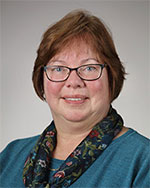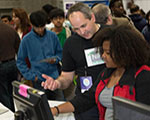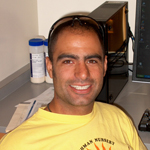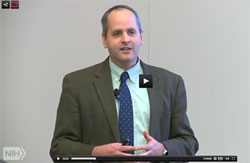 I’m very pleased to announce the selection of Rochelle Long as director of our Division of Pharmacology, Physiology, and Biological Chemistry (PPBC). Rochelle is a pharmacologist who has played leading roles in fostering research in pharmacogenomics through national and international collaborations.
I’m very pleased to announce the selection of Rochelle Long as director of our Division of Pharmacology, Physiology, and Biological Chemistry (PPBC). Rochelle is a pharmacologist who has played leading roles in fostering research in pharmacogenomics through national and international collaborations.
She established and oversees the trans-NIH Pharmacogenomics Research Network and has catalyzed associated partnerships, such as the Global Alliance for Pharmacogenomics and the Clinical Pharmacogenetics Implementation Consortium.
Rochelle has worked in PPBC since 1990, starting as a program director and rising to become chief of its Pharmacological and Physiological Sciences Branch in 1998. She has served as acting division director since Mike Rogers’ retirement in May 2015.
Rochelle’s plans include building bridges across scientific disciplines, working to strengthen emerging fields and promoting cross-disciplinary research. These are goals across the Institute—they are reflected in our strategic plan—and they’re particularly relevant for a broad-ranging division like PPBC.
Since I’ve had the opportunity to interact with her for several years, I know how skilled Rochelle is at organizing, motivating and generating cohesion among groups of people. These qualities will serve her well as PPBC director and as a member of the NIGMS senior leadership team.
For more about Rochelle, see our news announcement.


 A few weeks ago, 23 NIGMS volunteers and I spent an amazing day with thousands of highly engaged kids, their parents and other science enthusiasts of all ages at the Washington, DC, Convention Center. We were participating in the USA Science & Engineering Festival, the largest STEM event in the nation.
A few weeks ago, 23 NIGMS volunteers and I spent an amazing day with thousands of highly engaged kids, their parents and other science enthusiasts of all ages at the Washington, DC, Convention Center. We were participating in the USA Science & Engineering Festival, the largest STEM event in the nation.
 I encourage you to share your own enthusiasm for science with young people whenever you have the opportunity. Whether you judge a science fair, speak at a career day or have students visit your lab, you put a human face on science and help students see it as an exciting, fulfilling and worthy career choice.
I encourage you to share your own enthusiasm for science with young people whenever you have the opportunity. Whether you judge a science fair, speak at a career day or have students visit your lab, you put a human face on science and help students see it as an exciting, fulfilling and worthy career choice. I’m very pleased to announce a new annual lecture to highlight the achievements of some of NIGMS’ early career grantees.
I’m very pleased to announce a new annual lecture to highlight the achievements of some of NIGMS’ early career grantees.

 I’m very pleased to announce that Dorit Zuk will be joining us in early 2016 as the new director of our Division of Genetics and Developmental Biology (GDB). Dorit is a molecular biologist whose research has focused on muscle development and RNA metabolism. She also has a strong background in science policy and communications.
I’m very pleased to announce that Dorit Zuk will be joining us in early 2016 as the new director of our Division of Genetics and Developmental Biology (GDB). Dorit is a molecular biologist whose research has focused on muscle development and RNA metabolism. She also has a strong background in science policy and communications. I’m very pleased to announce that Alison Gammie will be joining us in the late summer as the new director of our Division of Training, Workforce Development, and Diversity (TWD). She’s currently a senior lecturer in molecular biology at Princeton as well as an innovator and leader in teaching, mentoring, diversity-building and recruitment programs there. Through collaborations and other approaches, she has also contributed in many ways to improving undergraduate STEM training on a national level.
I’m very pleased to announce that Alison Gammie will be joining us in the late summer as the new director of our Division of Training, Workforce Development, and Diversity (TWD). She’s currently a senior lecturer in molecular biology at Princeton as well as an innovator and leader in teaching, mentoring, diversity-building and recruitment programs there. Through collaborations and other approaches, she has also contributed in many ways to improving undergraduate STEM training on a national level.